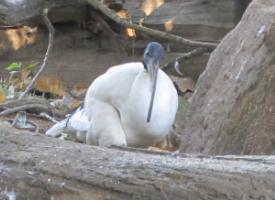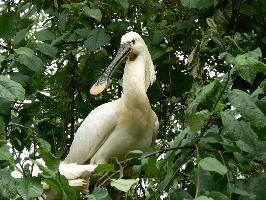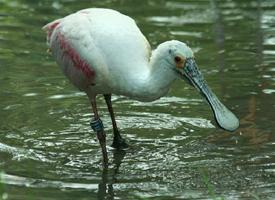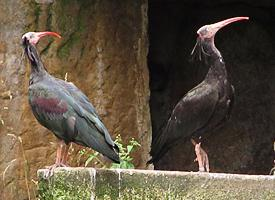
Popis zvířete
The African sacred ibis (Threskiornis aethiopicus) is a striking bird species that belongs to the family Threskiornithidae, which includes ibises and spoonbills. This bird has garnered attention and reverence across various cultures, especially in ancient Egypt, where it was considered a symbol of wisdom and associated with the deity Thoth. The species' name itself, 'aethiopicus,' is indicative of its African roots, pointing to its widespread distribution across sub-Saharan Africa and some parts of the Middle East.Physically, the African sacred ibis is a medium to large bird, measuring approximately 65 to 75 cm in length, with a wingspan that can extend up to 112 to 124 cm. Its plumage is predominantly white, which starkly contrasts with its black head, neck, and legs. The bird's head and neck are devoid of feathers, revealing a dark, wrinkled skin that adds to its distinct appearance. One of its most notable features is its long, down-curved bill, which is not only an adaptation for its feeding habits but also contributes to its unique profile. The bill is sharp and powerful, perfectly designed for foraging in the mud and shallow water for its diet, which mainly consists of various fish, frogs, small mammals, reptiles, and invertebrates, as well as some seeds and scraps.
The African sacred ibis is a social bird, often found in flocks that can number in the hundreds, especially during the breeding season. These birds are known for their communal nesting habits, with colonies establishing large, noisy rookeries in trees, reed beds, or on cliffs, often near water bodies like lakes, rivers, and marshes. The nests are constructed from reeds, branches, and leaves, with both parents involved in the building process. A typical clutch consists of 2 to 3 eggs, which are incubated by both parents for about 28 to 29 days. The chicks are altricial, meaning they are born relatively undeveloped and require considerable parental care before they fledge at about 6 to 7 weeks of age.
Despite its revered status in ancient cultures, the African sacred ibis faces challenges in the modern world. Its habitat is increasingly threatened by wetland degradation and pollution, leading to a decline in some populations. However, in some regions, it has adapted well to human-altered landscapes, finding new nesting sites and food sources. The species is currently listed as of Least Concern by the International Union for Conservation of Nature (IUCN), reflecting its wide distribution and relatively stable population size. Nevertheless, continued monitoring and conservation efforts are essential to ensure that this iconic species remains a part of Africa's rich biodiversity.
In summary, the African sacred ibis is a fascinating bird, both in terms of its physical characteristics and its cultural significance. Its adaptability and social nature have allowed it to thrive in diverse habitats, but it remains imperative to protect the natural environments that support it and countless other species.
Podobná zvířata
Nové fotografie zvířat
Top 10 zvířat
- Chinese water dragon (Physignathus cocincinus)
- Galápagos tortoise (Geochelone nigra complex)
- Dolphin gull (Leucophaeus scoresbii)
- Japanese macaque (Macaca fuscata)
- Colombian red howler (Alouatta seniculus)
- Sea urchins (Echinoidea)
- Moustached guenon (Cercopithecus cephus)
- Diana monkey (Cercopithecus diana)
- Common reed warbler (Acrocephalus scirpaceus)
- Common house mosquito (Culex pipiens)


